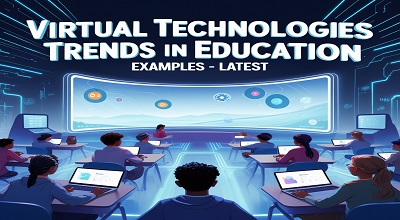Virtual Technologies Trends in Education
Virtual Technologies Trends in Education: The education sector is undergoing a digital transformation, with virtual technologies playing a pivotal role in reshaping how students learn and educators teach. From Virtual Reality (VR) to Artificial Intelligence (AI), these innovations are enhancing engagement, accessibility, and personalized learning experiences.
This article explores the latest virtual technology trends in education, provides real-world examples, and discusses their benefits, challenges, and future potential.
The Rise of Virtual Technologies in Education
The integration of virtual technologies in education has accelerated due to advancements in AI, VR, AR, and cloud computing. The COVID-19 pandemic further emphasized the need for digital learning solutions, leading schools and universities to adopt immersive and interactive tools.
These technologies are breaking geographical barriers, enabling remote learning, and offering students hands-on experiences through simulations and gamification.
Latest Virtual Technology Trends in Education
Virtual Reality (VR) in Classrooms
VR creates immersive 3D environments where students can explore historical sites, conduct science experiments, or even travel through space.
Example:
- Google Expeditions allows students to take virtual field trips to the Great Wall of China or the International Space Station.
Augmented Reality (AR) for Interactive Learning
AR overlays digital content onto the real world, making abstract concepts tangible.
Example:
- Microsoft HoloLens is used in medical schools to visualize human anatomy in 3D.
Artificial Intelligence (AI) and Personalized Learning
AI-powered platforms analyze student performance and adapt lessons accordingly.
Example:
- Duolingo uses AI to customize language learning paths based on user progress.
Gamification and Immersive Learning
Gamification makes learning fun by incorporating game-like elements.
Example:
- Minecraft: Education Edition teaches coding, history, and teamwork through interactive gameplay.
Cloud-Based Learning Platforms
Cloud computing enables access to educational resources anytime, anywhere.
Example:
- Coursera & edX offer online courses from top universities via cloud platforms.
Blockchain for Secure Credentialing
Blockchain ensures tamper-proof academic records and digital diplomas.
Example:
- MIT issues blockchain-based digital diplomas to prevent credential fraud.
The Metaverse and Virtual Campuses
The metaverse allows students to attend virtual classes in a 3D digital space.
Example:
- Meta’s Horizon Workrooms provides virtual meeting spaces for educators and students.
5G and Enhanced Connectivity
5G enables seamless streaming of high-quality VR/AR content without lag.
Example:
- South Korean schools use 5G-powered VR labs for real-time collaborative learning.
Examples of Virtual Technologies in Education
Google Expeditions (VR Field Trips)
- Used in K-12 schools for immersive history and science lessons.
Microsoft HoloLens (AR in Medical Training)
- Helps medical students practice surgeries in a risk-free environment.
Duolingo (AI-Powered Language Learning)
- Adapts lessons based on user mistakes and progress.
Minecraft: Education Edition (Gamified Learning)
- Teaches STEM subjects through collaborative building challenges.
Coursera & edX (Cloud-Based Learning)
- Provides access to Ivy League courses remotely.
MIT’s Blockchain Certificates
- Ensures secure and verifiable digital diplomas.
Meta’s Horizon Workrooms (Virtual Classrooms)
- Enables interactive 3D learning environments.
Benefits of Virtual Technologies in Education
- Enhanced Engagement: Interactive and immersive learning keeps students motivated.
- Accessibility: Remote learners can access high-quality education.
- Personalized Learning: AI tailors lessons to individual needs.
- Cost-Effective: Reduces the need for physical resources like textbooks.
- Real-World Skills: Prepares students for tech-driven careers.
Challenges and Limitations
- High Costs: VR/AR devices and AI software can be expensive.
- Technical Issues: Requires strong internet and hardware support.
- Training for Educators: Teachers need professional development to use these tools effectively.
- Privacy Concerns: AI and blockchain raise data security questions.
Future of Virtual Technologies in Education
- Wider adoption of AI tutors and metaverse campuses.
- Expansion of VR/AR in vocational training.
- Increased use of blockchain for lifelong learning records.
Conclusion
Virtual technologies are revolutionizing education by making learning more interactive, accessible, and personalized. While challenges exist, the benefits far outweigh the limitations, paving the way for a tech-driven future in education.
FAQs
Q1: How is VR different from AR in education?
- VR creates fully immersive digital environments, while AR overlays digital elements onto the real world.
Q2: Can AI replace teachers?
- No, AI enhances teaching by personalizing learning but cannot replace human educators.
Q3: Are virtual technologies expensive for schools?
- Initial costs can be high, but long-term benefits like scalability and engagement justify the investment.
Q4: How does blockchain help in education?
- It secures academic credentials, preventing fraud and simplifying verification.
Q5: What is the future of the metaverse in education?
It will enable 3D virtual classrooms, global collaboration, and immersive training simulations.
Free Here: Six6s Casino App
